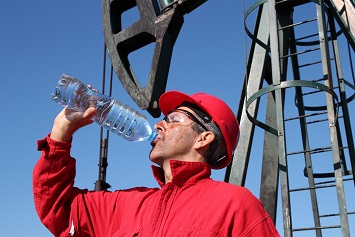Heat is the invisible factor that affects your workforce. This summer and in the summers to come, temperatures are only projected to get hotter and more variable, so it’s increasingly important to know how to keep your employees safe while they work in the heat.
Aside from outfitting your workforce in smart personal protective equipment (PPE) that allows you to monitor them on a real-time, daily basis and keep them safe in extreme environments, there are several things you can do that are also effective.
Setting up the Worksite
Make sure there are easily accessible cooling stations for your team members that are less than a 5-minute walk from where they’re working. Here are some key considerations for creating your worksite cooling stations.
- The cooling stations should have an ample supply of potable water that is kept cool and is near the workers’ rest stations.
- These stations should also be under shade or in an air-conditioned area.
- There should be a means to reach emergency services at each station in case a worker needs to undergo extreme and immediate cooling.
- At least one chair or cot should be available at the cooling station in case a worker needs to sit or, if he or she is feeling light-headed, to lay down with his or her legs propped up on the chair to help return blood flow to the heart and brain.
- There should be an emergency ice bath or cooling system available, such as an ice chest that contains cold compresses, kept within a short (i.e., less than 10 minutes) walk from all highly populated worksites. If the distance from worksites is greater, a mode of transportation should be provided for workers to get to these ice baths quickly if needed. Ice water baths are the number one way to save lives and prevent exertional heatstroke and death. You can also use a tarp (cradled around the individual) filled with ice and water in place of a tub.
- Along with the ice bath, you will need to fill a chest of ice each day and make sure there is an ample supply of water present near the ice bath to quickly fill or refill the tub. If this is not possible, make sure cold compresses, an ice chest, and a cooler of water are placed near the highly populated worksites each day in case of emergency.
Educating Your Workforce
Make sure you educate yourself and your workers about the signs and symptoms of heat injury and illness, and encourage your workers to be honest when they’re not feeling well. Ensure they take breaks when needed to allow them to stay hydrated and at normal body temperatures throughout the workday. Educate your workers on the dangers of ignoring their signs and symptoms, as well; ignoring changes in their bodies could result in a serious heat injury or illness that will prevent them from working for days or even weeks.
If you don’t have individualized monitoring, you should employ work-rest schedules at your site, which are calculated based on workers’ clothing, the air temperature in the work environment, the humidity, sun exposure, and workload. You should check these work-rest tables each day to assess how long workers should be resting vs. working every hour. But be aware that these work-rest schedules are not specific to each individual, so there will be some individuals who need to rest earlier and some who can keep working despite the prescribed work schedules.
Workers should be made aware that these work-rest schedules are not “one-size-fits-all” and that they may need to stop sooner, or be able to work longer, than what’s prescribed. Many factors unique to each individual (e.g., age, sex, medications) will change how well a worker can tolerate the heat, which will affect how well he or she can work in the heat.
Let Workers Take Breaks When Needed
Letting your workers take breaks when needed—ideally resting for 10 to 15 minutes each hour when it’s very hot and humid—will help them keep their core body temperature lower and allow them to stay hydrated. This, in turn, allows them to work harder and longer while ensuring they stay alert and focused on the job.
If you push your workers too far, you can put them at risk of heat injuries and illnesses. Depending on which injuries or illnesses your workers obtain and the severity of the incident, they could be out of work for a day or up to several weeks. When in doubt, listen to your workers when they need to rest, and err on the side of caution by giving them a 10- to 15-minute break each hour to cool down. This will ensure your workforce stays safe and productive instead of risking long-term absences from work due to heat illness.
By making a commitment to stay informed and share your knowledge of heat safety with your workforce, your entire team will stay healthy, safe, and productive.
 Nicole Moyen leads research and development at Kenzen, a smart PPE innovator whose real-time heat monitoring system is used by companies to keep workers safe from heat. Moyen has a decade of research experience in industry and academia related to human physiology and wearable devices, and she advises companies on heat stress physiology and dehydration. She has an MS in Exercise Physiology and is currently finishing her PhD in Biology from Stanford University. Read more from Nicole Moyen on Kenzen’s blog. Nicole Moyen leads research and development at Kenzen, a smart PPE innovator whose real-time heat monitoring system is used by companies to keep workers safe from heat. Moyen has a decade of research experience in industry and academia related to human physiology and wearable devices, and she advises companies on heat stress physiology and dehydration. She has an MS in Exercise Physiology and is currently finishing her PhD in Biology from Stanford University. Read more from Nicole Moyen on Kenzen’s blog. |

